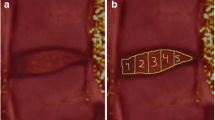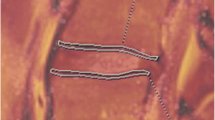Abstract
Purpose
To investigate differences in functional intervertebral disk (IVD) characteristics between low back pain (LBP) patients and controls using T2-mapping with axial loading during MRI (alMRI).
Methods
In total, 120 IVDs in 24 LBP patients (mean age 39 years, range 25–69) were examined with T2-mapping without loading of the spine (uMRI) and with alMRI (DynaWell® loading device) and compared with 60 IVDs in 12 controls (mean age 38 years, range 25–63). The IVD T2-value was acquired after 20-min loading in five regions of interests (ROI), ROI1-5 from anterior to posterior. T2-values were compared between loading states and cohorts with adjustment for Pfirrmann grade.
Results
In LBP patients, mean T2-value of the entire IVD was 64 ms for uMRI and 66 ms for alMRI (p = 0.03) and, in controls, 65 ms and 65 ms (p = 0.5). Load-induced T2-differences (alMRI–uMRI) were seen in all ROIs in both patients (0.001 > p < 0.005) and controls (0.0001 > p < 0.03). In patients, alMRI induced an increase in T2-value for ROI1-3 (23%, 18% and 5%) and a decrease for ROI4 (3%) and ROI5 (24%). More pronounced load-induced decrease was detected in ROI4 in controls (9%/p = 0.03), while a higher absolute T2-value was found for ROI5 during alMRI in patients (38 ms) compared to controls (33 ms) (p = 0.04).
Conclusion
The alMRI-induced differences in T2-value in ROI4 and ROI5 between patients and controls most probably indicate biomechanical impairment in the posterior IVD regions. Hence, alMRI combined with T2-mapping offers an objective and clinical feasible tool for biomechanical IVD characterization that may deepen the knowledge regarding how LBP is related to altered IVD matrix composition.
Graphical abstract
These slides can be retrieved under Electronic Supplementary Material.



Similar content being viewed by others
References
Iatridis JC, Nicoll SB, Michalek AJ, Walter BA, Gupta MS (2013) Role of biomechanics in intervertebral disc degeneration and regenerative therapies: what needs repairing in the disc and what are promising biomaterials for its repair? Spine J 13(3):243–262
Jarvik JG, Deyo RA (2002) Diagnostic evaluation of low back pain with emphasis on imaging. Ann Intern Med 137(7):586–597
Belavý DL, Quittner MJ, Ridgers N, Ling Y, Connell D, Rantalainen T (2017) Running exercise strengthens the intervertebral disc. Sci Rep 7:45975
Iatridis JC, Kang J, Kandel R, Risbud MV (2017) New horizons in spine research: intervertebral disc repair and regeneration. J Orthop Res 35(1):5
Ellingson AM, Mehta H, Polly Jr DW, Ellermann J, Nuckley DJ (2013) Disc degeneration assessed by quantitative T2*(T2 star) correlated with functional lumbar mechanics. Spine 38(24):E1533–E1540
Chiu EJ, Newitt DC, Segal MR, Hu SS, Lotz JC, Majumdar S (2001) Magnetic resonance imaging measurement of relaxation and water diffusion in the human lumbar intervertebral disc under compression in vitro. Spine (Phila Pa 1976) 26(19):E437–E444
Antoniou J, Epure LM, Michalek AJ, Grant MP, Iatridis JC, Mwale F (2013) Analysis of quantitative magnetic resonance imaging and biomechanical parameters on human discs with different grades of degeneration. J Magn Reson Imaging 38(6):1402–1414
Mwale F, Demers CN, Michalek AJ, Beaudoin G, Goswami T, Beckman L, Iatridis JC, Antoniou J (2008) Evaluation of quantitative magnetic resonance imaging, biochemical and mechanical properties of trypsin-treated intervertebral discs under physiological compression loading. J Magn Reson Imaging 27(3):563–573. https://doi.org/10.1002/jmri.21242
Mwale F, Iatridis JC, Antoniou J (2008) Quantitative MRI as a diagnostic tool of intervertebral disc matrix composition and integrity. Eur Spine J 17(4):432
Nilsson M, Lagerstrand K, Kasperska I, Brisby H, Hebelka H (2016) Axial loading during MRI influences T2-mapping values of lumbar discs: a feasibility study on patients with low back pain. Eur Spine J 25(9):2856–2863. https://doi.org/10.1007/s00586-016-4670-6
Messner A, Stelzeneder D, Trattnig S, Welsch GH, Schinhan M, Apprich S, Brix M, Windhager R, Trattnig S (2017) Does T2 mapping of the posterior annulus fibrosus indicate the presence of lumbar intervertebral disc herniation? A 3.0 Tesla magnetic resonance study. Eur Spine J 26(3):877–883
Torén L, Hebelka H, Kasperska I, Brisby H, Lagerstrand K (2018) With axial loading during MRI diurnal T2-value changes in lumbar discs are neglectable: a cross sectional study. BMC Musculoskelet Disord 19(1):25
Malko JA, Hutton WC, Fajman WA (1999) An in vivo magnetic resonance imaging study of changes in the volume (and fluid content) of the lumbar intervertebral discs during a simulated diurnal load cycle. Spine 24(10):1015–1022
Abdollah V (2017) The effects of axial loading on the disc and motion segments relative to disc degeneration and pain using novel MRI biomarkers. University of Alberta. https://era.library.ualberta.ca/files/cnz805z93w/Abdollah_Vahid_201701_PhD.pdf
Stelzeneder D, Kovacs BK, Goed S, Welsch GH, Hirschfeld C, Paternostro-Sluga T, Friedrich KM, Mamisch TC, Trattnig S (2012) Effect of short-term unloading on T2 relaxation time in the lumbar intervertebral disc—in vivo magnetic resonance imaging study at 3.0 tesla. Spine J 12(3):257–264. https://doi.org/10.1016/j.spinee.2012.02.001
Chokan K, Murakami H, Endo H, Mimata Y, Yamabe D, Tsukimura I, Oikawa R, Doita M (2016) Evaluation of water retention in lumbar intervertebral disks before and after exercise stress with T2 mapping. Spine 41(7):E430–E436
Yamabe D, Murakami H, Chokan K, Endo H, Oikawa R, Sawamura S, Doita M (2017) Evaluation of water content in lumbar intervertebral discs and facet joints before and after physiological loading using T2 mapping MRI. Spine 42(24):E1423–E1428
Nazari J, Pope MH, Graveling RA (2015) Feasibility of Magnetic resonance imaging (MRI) in obtaining nucleus pulposus (NP) water content with changing postures. Magn Reson Imaging 33(4):459–464
Willen J, Danielson B (2001) The diagnostic effect from axial loading of the lumbar spine during computed tomography and magnetic resonance imaging in patients with degenerative disorders. Spine (Phila Pa 1976) 26(23):2607–2614
Danielson BI, Willen J, Gaulitz A, Niklason T, Hansson T (1998) Axial loading of the spine during CT and MR in patients with suspected lumbar spinal stenosis. Acta Radiol 39(6):604–611
Pfirrmann CW, Metzdorf A, Zanetti M, Hodler J, Boos N (2001) Magnetic resonance classification of lumbar intervertebral disc degeneration. Spine (Phila Pa 1976) 26(17):1873–1878
Aprill C, Bogduk N (1992) High-intensity zone: a diagnostic sign of painful lumbar disc on magnetic resonance imaging. Br JRadiol 65(773):361–369
Landis JR, Koch GG (1977) The measurement of observer agreement for categorical data. Biometrics 33(1):159–174
Lee S-H, Derby R, Chen Y, Seo KS, Kim MJ (2004) In vitro measurement of pressure in intervertebral discs and annulus fibrosus with and without annular tears during discography. Spine J 4(6):614–618
Maquer G, Brandejsky V, Benneker LM, Watanabe A, Vermathen P, Zysset PK (2014) Human intervertebral disc stiffness correlates better with the Otsu threshold computed from axial T2 map of its posterior annulus fibrosus than with clinical classifications. Med Eng Phys 36(2):219–225. https://doi.org/10.1016/j.medengphy.2013.11.008
Trattnig S, Stelzeneder D, Goed S, Reissegger M, Mamisch TC, Paternostro-Sluga T, Weber M, Szomolanyi P, Welsch GH (2010) Lumbar intervertebral disc abnormalities: comparison of quantitative T2 mapping with conventional MR at 3.0 T. Eur Radiol 20(11):2715–2722
Ogon I, Takebayashi T, Takashima H, Tanimoto K, Ida K, Yoshimoto M, Fujiwara H, Kubo T, Yamashita T (2015) Analysis of chronic low back pain with magnetic resonance imaging T2 mapping of lumbar intervertebral disc. J Orthop Sci 20(2):295–301
Passias PG, Wang S, Kozanek M, Xia Q, Li W, Grottkau B, Wood KB, Li G (2011) Segmental lumbar rotation in patients with discogenic low back pain during functional weight-bearing activities. J Bone Jt Surg Am 93(1):29
Mok GS, Zhang D, Chen S-Z, Yuan J, Griffith JF, Wang YXJ (2016) Comparison of three approaches for defining nucleus pulposus and annulus fibrosus on sagittal magnetic resonance images of the lumbar spine. J Orthop Transl 6:34–41
Acknowledgements
The authors acknowledge support from C4I center, Sahlgrenska University Hospital, Konrad Helfrid Johansson’s Foundation, Felix Neubergh Foundation, ALF Grant Västra Götaland Region and Grant AFA Insurance Company.
Author information
Authors and Affiliations
Corresponding author
Ethics declarations
Conflict of interest
The authors declare that they have no conflict of interest.
Ethical approval
All procedures performed involving human participants were in accordance with the ethical standards of the institutional and/or national research committee and with the 1964 Helsinki Declaration and its later amendments or comparable ethical standards.
Informed consent
Oral and written informed consent was obtained from all individual participants included in the study.
Electronic supplementary material
Below is the link to the electronic supplementary material.
Rights and permissions
About this article
Cite this article
Hebelka, H., Torén, L., Lagerstrand, K. et al. Axial loading during MRI reveals deviant characteristics within posterior IVD regions between low back pain patients and controls. Eur Spine J 27, 2840–2846 (2018). https://doi.org/10.1007/s00586-018-5774-y
Received:
Revised:
Accepted:
Published:
Issue Date:
DOI: https://doi.org/10.1007/s00586-018-5774-y




